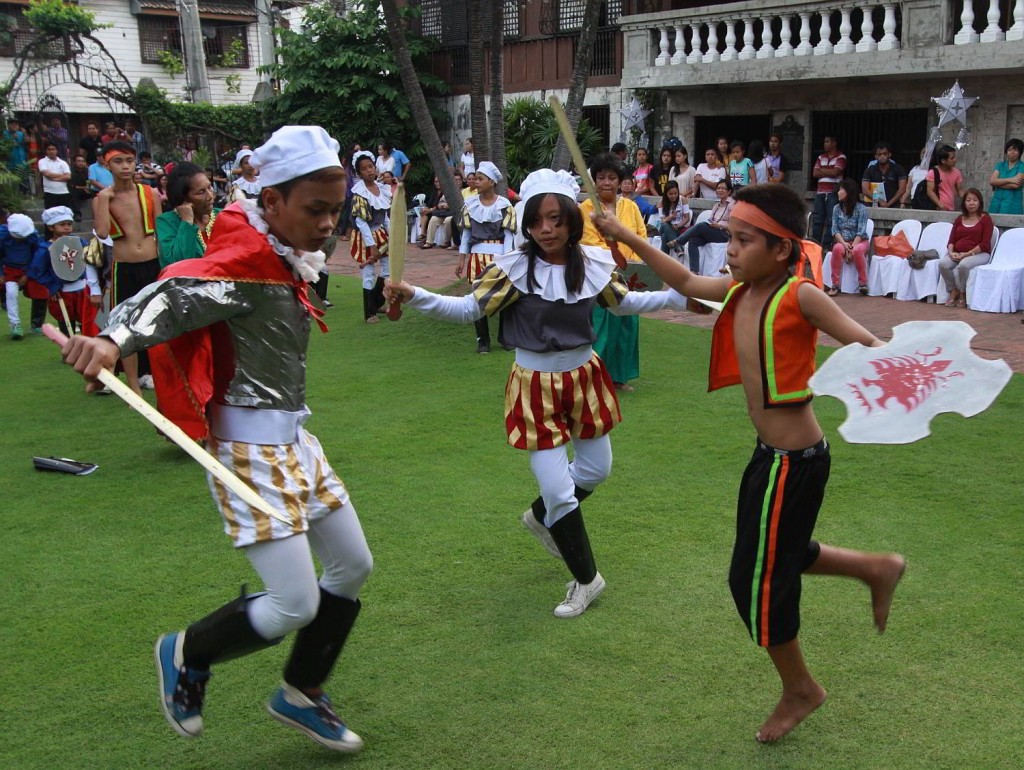
Children from Mabolo perform the Cebuano “sinug” in last year’s Casa Gorordo event. This prayer dance narrates a battle between Spanish soldiers and island natives, and the peace brought about by the Sto. Niño.
(CDN PHOTO/JUNJIE MENDOZA)
Nang Titang” Diola is no longer around to dance her prayers for the Sto. Niño but her neighborhood dance troupe continues the tradition of the “Sinug sa Casa Gorordo” on Monday, January 20 at 2 p.m.
On the front lawn of Casa Gororo Museum, Nang Titang’s descendants and children of barangay Mabolo will again participate in the Sinug dance ritual, with its distinct echoes of pre-Spanish culture and Catholic piety.
Estelita “Nang Titang” Diola, dubbed the keeper of the Sinug, died in March last year at the age of 88.
As it does every year in keeping with traditions of the Gorordo family and the Parian area, the Ramon Aboitiz Foundation, Inc. (RAFI) Casa Gorordo Museum will hold the Sinug dance ritual that will be performed by Diola’s group, the Turang Dance Troupe from Mabolo.
The dancers, mostly boys and girls, will now be led by Carolina Diola and Rommel Borja, descendants of Estelita ‘Nang Titang’ Diola.
Nang Titang was able to pass her knowledge of the Sinug to her relatives, who continue the tradition. She learned the dance steps when she was seven years old from her father, Buenaventura ‘Turang’ Diola and was taught the beat by Mariano ‘Iklot’ Bontilao.
The more popular Sinulog, which Cebuanos and visitors see in parades leading up to the Grand Parade on Sunday, January 19, differ is different Titang’s Sinug in many ways.
The less known Sinug dance has its own fixed format and unique beat and steps not present in the Sinulog, despite the fact that both dances pay homage to the Señor Sto. Niño.
Interestingly, the Sinug does not have a dancing “reyna” or female dancer who carries the image of the Señor in the Sinulog. Instead, the icon of the Holy Child is placed with reverance on an altar facing the dancers.
The dance narrates the coming of Christianity to the Philippines, the conflict between island natives and the Spaniards, and eventual peace between the two forces through the intercession of the Sto. Niño.
The Sinug dancers were traditionally invited by the Gorordo family and other Parian families who wished to pray for the souls of their departed loved ones in this special way, on the Monday after the fiesta of the Holy Child.
Believing that the dance ritual is worth preserving for the next generationsto witness and experience, RAFI has supported the group’s efforts to insure that the Sinug tradition lives on.
An exhibit about Titang Diola will also open after the performance.
The Casa Gorordo Museum carries out other house traditions like the Kuwaresma Procession, Pista ni San Juan and the displaying of the Gorordo Belen in Christmas.
For inquiries, please call Karl Hegel Damayo at 4187234 loc. 703 or 2555630.